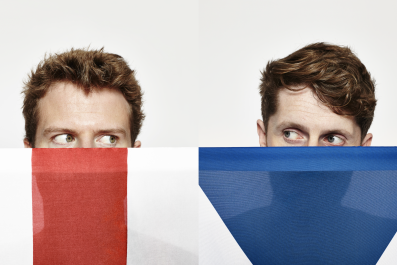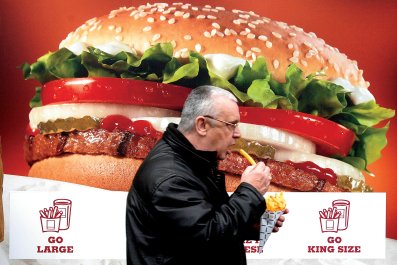Seventy-five years ago, on August 26, 1939, an experimental New York TV station for the first time broadcast a professional baseball game. The Brooklyn Dodgers, playing at Ebbets Field, split a double-header with the Cincinnati Reds. In the stands, 33,000 people cheered. A paltry 3,000 early-TV geeks watched at home, peering into screens the width of a toaster.
That 1939 broadcast barely hinted at how the technology of television would fundamentally change the relationship between sports and society. But now that kind of historic shift is happening again, this time with the explosion of data technology in sports. In coming years, data will rejigger the power and popularity of different sports.
Maybe data will save baseball. The top task for Major League Baseball's incoming commissioner, Rob Manfred, is to try to make a lullaby-paced sport that takes three hours per game relevant to the Snapchat generation. This season the league began installing a phalanx of gadgets and systems that will collect and analyze data about every sliver of action in every game, clearly betting that data will add a Twilight Zone-like dimension to baseball that no one can yet see. Claudio Silva, the scientist MLB hired to help make sense of the data, is authoring an academic paper titled "Baseball 4D."
Other pro sports leagues have suddenly gone data crazy. The National Football League just announced plans to put radio tracking sensors in every player's shoulder pads. (Maybe the NFL borrowed the technology from crash test dummies wired to measure how hard they hit the windshield.) Last season the National Basketball Association installed technology that can track millions of data points in each game—every player's movement and everywhere the ball goes.
Sports coaches, executives and analysts agree that these systems will provide new insights for fans and management. But no one can yet predict the macro trend that will ride on the emergence of a new sports-delivery technology. Surely, though, there will be one. There always is.
Mass-market newspapers emerged toward the end of the 19th century as immigrants ballooned the U.S. population and engineers invented high-speed printing presses. The first sportswriters wrote mostly about boxing, baseball and college football. Newspapers made sports into more than isolated events experienced only by those who were there. Fans could read about a game after the fact. By expanding the fan base, journalism made it possible for sports to sustain professional leagues.
In the 1920s, radio broadcasts allowed people to hear a game in real time. The excitement of a game could be felt as it was happening, in every living room. Radio, Babe Ruth's New York Yankees and the blistering economy of the Roaring '20s turned baseball into America's pastime—the first widely popular professional sport.
After World War II, televisions poured into U.S. households. In 1950, 9 percent of U.S. homes had a TV. Only 12 years later, it was 90 percent. Just about everyone could now see a game live—a phenomenal change in the relationship between fans and sports. In 1950, the NFL was a pipsqueak league. It didn't play well in print or on radio. But it killed on TV. Visual technology created a new professional sports powerhouse, and the NFL is now the dominant sport of the TV era.
As with TV in the 1950s, we're now in the heart of a technology surge. Cloud computing over smart devices is bringing big data to every fan of every sport. By the end of this year, about 1.7 billion people worldwide will own a smartphone, up from nearly zero a decade ago. All those smartphone apps go out over wireless networks to tap into huge stores of information and massive computing power in gigantic data centers. The cloud puts big data in our pockets.
Print let us read about a past sporting event. Radio let us hear it live. TV let us see it. And data? It will let us understand a sport. We'll be able to see and manipulate its insides. It will be the difference between seeing a house from the curb and living in it.
To try to get an idea of what that might mean, I visited Silva, who is doing his MLB data work out of his office at New York University. Baseball now has multiple data streams to work with: PITCHf/x tracks the speed, spin and placement of every pitch; radar tracks the ball on the field; motion-capture cameras plot the movement of players. The goal, Silva says, is to have so much information, a game could be re-created completely by using data.
Baseball would come to exist in an entirely digital form, which could be manipulated by fans to perhaps create new games. You might be able to tap into a previously played baseball game and create a new game by taking charge of calling the pitches: curve, strike, changeup. Then watch as a real-time, realistic version of the game unfolds as you play. Or maybe you could do that through Google Glass while at a live game: Call a different pitch and see what might have happened in the live at-bat you just witnessed.
"It's a different view into the game—an augmented-reality view," Silva says. He emphasizes that this is all still an experiment, and that the public and other computer whizzes will make new versions of baseball out of data. "We're going to be able to comb through this data and find layers and layers of features that we never could see before," he says.
This could be baseball's comeback. Data could make the game exciting intellectually, just as more people are coming to regard football as a brutal TV spectacle. Played right, a data-enhanced MLB could make football seem like a two-dimensional sport on a flat-screen at a time of 4-D sports.
Or perhaps data will uplift a new sport, the way TV ushered in the NFL. There are sports that pretty much defy television coverage—bicycle racing, for one, or even hockey, with its tiny puck and blink-and-you-miss-it speed. Expect intense data to create a new kind of sports excitement—less visceral, more analytical—that translates a non-TV event into a perfect smartphone event. This could turn the Tour de France into a global obsession, and make bike racing as addictive as Candy Crush.
All this is still a great unknown. What is clear is that we've reached a new dividing line in sports. Newspapers, radio, TV, data. We are now in a new era that is waiting for some sport to claim it. MLB is stepping up to the plate. Let's see whether it whiffs or hits one out of the park.






























